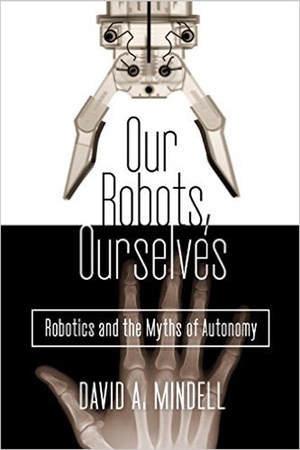Review: Our Robots, Ourselvesby Jeff Foust
|
| “The sentiment seems odd because it suggests that the major reason to send people to Mars would be speed, which few suggest as a rationale,” he writes. |
Spaceflight, though, is not the only field where debates regarding humans and robotic systems are playing out. In the air and under the ocean, the use of human-controlled and autonomous systems has been argued for years. More recently, a number of companies, led by Google, have been developing cars that can drive themselves, promising a future where a human can step in, set his or her destination, and relax (or even take a nap) while the car drives itself.
The roles of autonomy in various systems, including spacecraft, is at the heart of Our Robots, Ourselves, a new book by MIT professor David Mindell. As the book’s subtitle suggests, Mindell thinks too much emphasis is placed on fully autonomous systems, be they self-driving cars or “autoland” technologies in aircraft. A better approach, he argues, are technologies that aid humans by providing guidance and handing some of the workload but still leaving humans in the loop, rather than on top of it.
One example, of many, he uses in his book is the operation of NASA’s Mars rovers. Despite the long time delays in communications between Mars and Earth, the rovers are controlled by teams on Earth, who carefully plot out paths for the rovers to take and tasks for them to do. The rovers become extensions of their teams back on Earth, something noted by others studying the missions (see “Review: Working on Mars”, The Space Review, September 24, 2012; and “Review: Seeing Like A Rover”, The Space Review, July 27, 2015).
The common complaint about the Mars rovers, though, is that they are slow: Mindell brings up comments by Steve Squyres, the lead scientist on the Mars Exploration Rovers mission, that the science the rovers take years to do could be done by a geologist in the field in days. Mindell, though, doesn’t see this as a problem. “The sentiment seems odd because it suggests that the major reason to send people to Mars would be speed, which few suggest as a rationale,” he writes (emphasis in original.) Nothing in geology, he notes, requires the “low latency” that humans on the surface of Mars, or even humans teleoperating robots from Mars orbit, would provide. After all, the rocks on Mars aren’t going anywhere any time soon.
NASA officials continue to argue that some of the key questions about Mars, including whether it ever hosted life, will eventually require boots on the ground. “I think it’s going to take humans on the surface of Mars to really get at the definitive evidence, to study that liquid water,” Ellen Stofan, NASA chief scientist and a field geologist, said at a congressional hearing last month (see “The Martian and real Martians”, The Space Review, October 5, 2015).
| “Human spaceflight is sort of founded on the premise that remote presence is not real presence,” he said. “But I’m not sure anyone under 40 believes that.” |
Mindell, who says he is not opposed to human spaceflight in general, just doesn’t see that scientific rationale for sending humans to Mars. “Is that a $100 billion problem?” he said during a discussion about the book last week during the New Horizons in Science conference at MIT, referring to the notional cost of a human mission. “I don’t think human spaceflight has ever been about marginally better cognitive skills or fine motor skills or anything like that.”
That conflict in perceptions, he suggested in last week’s discussion, is at least in part generational. “Human spaceflight is sort of founded on the premise that remote presence is not real presence,” he said. “But I’m not sure anyone under 40 believes that.”
Space is only a small part of Our Robots, Ourselves, which examines aircraft autopilots, UAVs, and submersibles, which Mindell has worked on for years, as areas where enhanced human-computer relationships, rather than full automation, offer the best solution. (The same is true, he notes near the end of the book, for self-driving cars.) Humans might one day walk on Mars, but science won’t be the primary reason for doing so, as scientists increasingly adapt to the remote, but very real, presence offered by rovers and other spacecraft.
